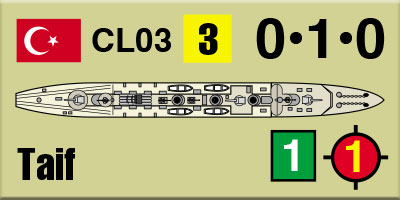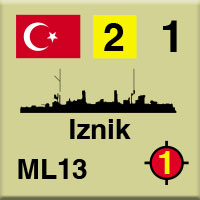Sword of the Sea:
The Ottoman Turkish Navy, Part Three
by Mike Bennighof, Ph.D.
May 2023
 In the world of the Second Great War, Woodrow Wilson negotiated a compromise peace in late 1916, bringing the First World War (the Great War) to an end. The Ottoman Empire survived, and over the years that followed reached a political compromise with its Arab and Kurdish subjects while pursuing the secular ideology of Mustafa Kemal Atatürk. In the world of the Second Great War, Woodrow Wilson negotiated a compromise peace in late 1916, bringing the First World War (the Great War) to an end. The Ottoman Empire survived, and over the years that followed reached a political compromise with its Arab and Kurdish subjects while pursuing the secular ideology of Mustafa Kemal Atatürk.
That dualism makes the interests of the Parliament in Damascus just as important as those of Ankara, and so the Ottoman Navy takes a much more direct role in defending the farther, Arab-inhabited reaches of the empire than was true before the Great War. The Red Sea Fleet is much smaller than the battle fleet stationed in the Sea of Marmara to react in either the Black Sea or Mediterranean. But it has an important role in internal politics, showing the Sultan’s commitment to defend his Arab lands from the infidel imperialists.
Most of the ships assigned to the Red Sea Fleet and Arabian Gulf Flotilla are older, refurbished veterans of the Great War. But there are a handful of modern units as well. Let’s conclude our look at the Ottoman ships of Second Great War at Sea: Sword of the Sea.
New Light Cruisers

In 1935 and 1936 the High Seas Fleet laid down a class of eight large light cruisers, but soon became dissatisfied with the design. The Breslau class ships were considered too large for a role that could be carried out by a smaller, less expensive ship. Six of the class would be completed for the Imperial Germany Navy, with the last two of them sold to the Ottoman Navy while still incomplete.
They’re as big as a heavy cruiser at 10,000 tons, carrying a dozen 150mm (5.9-inch) guns in three quadruple turrets. They also have a heavy torpedo armament, and carry a helicopter pad with stowage for two helicopters, but not a true hangar. They can make 34 knots, making them the fastest large combatants in the Turkish Red Sea Fleet.
Thanks to their range and robust construction, they’re true multi-role cruisers and among the most active Turkish units during peacetime, showing the moon star flag around the Indian Ocean and taking naval academy cadets to exotic locations on their highly-prized final-year cruises.
Old Light Cruisers

The German High Seas Fleet laid down a pair of mine-laying light cruisers in April 1915, completing them just as year later as they received priority for labor and materials. They did not participate in the Battle of Jutland, and saw little action before Wilson’s Peace brought the war to an end.
Despite their undoubted usefulness, the Imperial German Navy placed them in reserve with no plans to keep them in peacetime service. Ottoman naval attachés, alter to bargain purchases, quickly informed their superiors who pressed the Germans to make the sale. And for the price of their scrap value, the Ottoman Navy obtained two of its most effective units.

Minelaying cruiser Taif before modernization.
They’re weak surface combat units, carrying just four 150mm guns in shielded mounts and four torpedo tubes. Their value comes from their minelaying capacity: each of the two cruisers can carry and lay 450 mines. Their wartime task is to immediately seal the Strait of Bab el-Mandeb and keep the minefields renewed, using their speed to avoid enemy interference.
They underwent modernization at Taskizak Naval Shipyard during the early 1930’s, receiving new oil-fired boilers to maintain their 30-knot speed. Their armament remained un-altered, other than the provision of light anti-aircraft weapons.
Destroyers

At the close of the First Great War, the German High Seas Fleet lacked true destroyers, relying on small torpedo boats that lacked the capability to truly undertake all the roles demanded of destroyers in the rapidly-evolving naval environment. The large new Type 1918 (Mobilization) had been planned before the end of the war, but none had been laid down before the fighting ended.
Afterwards, the German Reichstag agreed to fund the construction of 31 of the 53 proposed destroyers, with the Ottoman Turkish fleet purchasing the other 22. Using a German military aid credit – in effect, the German government bought all 53 – the Turks obtained 22 then-modern boats. By 1940 all of them remained in service, a dozen of them with the main battle fleet and ten with the Red Sea Fleet.
Modernization in the 1930’s gave them new oil-fired boilers to maintain their speed of 34 knots, slightly less than they had theoretically made when new. They lost half of their torpedo tubes and one of their guns, instead doubling their mine-laying capacity from 45 to 90.
As rebuilt, their anti-aircraft armament remains minimal at best, and they carry only three 105mm guns and three torpedo tubes. But they are well-suited to their mission of supporting the mine-laying cruisers in the Red Sea.

For the surface combat role, the Turks selected the German “Stormbird” design, co-produced with a dozen boats built in Germany and eighteen more in Turkish yards with a fair amount of their weapons and equipment provided by German suppliers. The Storm Bird is a big destroyer, displacing 2,200 tons and carrying eight 128mm (5-inch) guns in four twin gunhouses. She also has six torpedo tubes, and light-anti-aircraft weaponry; her main armament lacks the elevation and fire control for anti-aircraft fire.
The Storm Birds can make 34 knots, and befitting her German origin is equipped to lay mines. They are formidable surface combatants, and usually draw the best officers and crew the Turkish Navy can offer.
Note: The Storm Bird destroyer, also seen in The Cruel Sea, is a rationalized version of the oversized Nazi German Type 1945 destroyer.
The Red Sea Fleet has eight of the boats, to counter the eight improved-Navigatori class destroyers of the Royal Italian Navy’s Red Sea Flotilla.
Mine Warfare
 
The Turkish Navy looks to mine warfare as the equalizer in its faceoff with multiple enemies in eastern waters. On top of the mine-laying cruisers and destroyers, the Turkish Navy has built a large class of specialized minelayers in Turkish yards. The Salda-class minelayers weigh in at 1,500 tons’ displacement, with the ability to lay 600 mines but minimal armament for their size: four 105mm heavy anti-aircraft guns, and lighter weapons. They do have good speed (22 knots) for their role. Two of them operate in the Arabian Gulf (what most nation call the Persian Gulf) and two in the Red Sea.
Aware that their enemies are equally capable of laying mines, the Turks operate a small force of minesweepers in both the Red Sea and Persian Gulf, and have added requisitioned civilian craft as auxiliary minesweepers. The purpose-built Balik-class boats are a Turkish design, built for rapid construction and equipped for minesweeping and coastal escort, but not intended as multi-role craft like the Imperial German Navy’s minesweepers.
You can order Sword the Sea right here.
Sign up for our newsletter right here. Your info will never be sold or transferred; we'll just use it to update you on new games and new offers.
Mike Bennighof is president of Avalanche Press and holds a doctorate in history from Emory University. A Fulbright Scholar and NASA Journalist in Space finalist, he has published a great many books, games and articles on historical subjects; people are saying that some of them are actually good.
He lives in Birmingham, Alabama with his wife, three children, and new puppy. He misses his lizard-hunting Iron Dog, Leopold.
Want to keep Daily Content free of third-party ads? You can send us some love (and cash) through this link right here.
|
